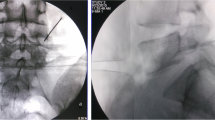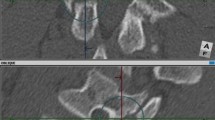Abstract
We present the clinical and radiological results of surgical repair for refractory spondylolysis in 20 patients at a minimum follow-up of 2 years. Seventeen of them were reassessed after 5 years. The Oswestry scores revealed good to excellent results in 90% (18/20 patients), indicating a good outcome with surgical repair using two techniques: the Scott procedure or pedicle screw and wire technique. Radiological pseudarthosis was 10%, which was quite consistent with reported series. CT scanning of the 14 patients after a mean of 13 months revealed complete healing of the fracture in 7 patients, partial in 2 and frank non-union in 5. Overall, CT examination with reversed gantry showed only 7/14 (50%) healing, indicating that radiological healing on plain X-ray is not always suggestive of complete bony healing. However, CT healing is not a sine qua non of good to excellent clinical outcome.
Résumé
Nous présentons les résultats cliniques et radiologiques des 20 patients présentant une récidive de spondylolyse avec un minimum de recul de 5 ans (7.5 ans). Le score d’Oswestry a montré un bon et un excellent résultat chez 90% des patients (18/20) en utilisant deux techniques, la technique de Scott ou la technique des vis pédiculaires avec fil métallique. La pseudarthrose radiologique est de 10%. Un scanner réalisé chez 14 patients avec un recul de 13 mois a montré une guérison complète de la fracture chez 7 patients, partielle chez 2 et une pseudarthrose dans 5 cas. L’examen au scanner a mis en évidence que le taux de guérison radiologique n’était que de 50%, néanmoins cette consolidation scannographique n’est pas nécessaire pour avoir un bon résultat final sur le plan clinique.


Similar content being viewed by others
References
Buck JE (1970) Further thoughts on direct repair of the defect in spondylolysis. J Bone Joint Surg [Br] 61:123
Debnath UK, Freeman BJC, Gregory P, de la Harpe D, Kerslake RW, Webb JK (2003) Clinical outcome and return to sport after the surgical treatment of spondylolysis in young athletes. Bone Joint Surg Br 85(2):244
Dreyzin V, Esses SI (1994) A comparative analysis of spondylolysis repair. Spine 19(17):1909, 1
Elliot BC, Davis JW, Khangure MS, Hardcastle PH, Foster D (1993) Disc degeneration and the young fast bowler in cricket. Clin Biomech 8:227
Fairbank J, Couper J, Daviews J, O’Brien J (1980) The Oswestry low back questionnaire. Physiotherapy 66:271
Gill GG, Manning JG, White HL (1955) Surgical treatment of spondylolisthesis without spine fusion. J Bone Joint Surg [Br] 37:493
Gillet P, Petit M (1999) Direct repair of spondylolysis without spondylolisthesis, using a rod-screw construct and bone grafting of the pars defect. Spine 24(12):1252
Goel VK, Lim TH (1989) Mechanics of spondylolisthesis. Semin Spine Surg 1:95
Hefti F (1997) Direct screw repair spondylolysis with the hooked screw. Orthopade 26:769
Ivanic GM, Pink TP, Achatz W, Ward JC, Homann NC, May M (2003) Direct stabilization of lumbar spondylolysis with a hook screw: mean 11-year follow-up period for 113 patients. Spine 28(3):255
Kakiuchi M (1997) Repair of the defect in spondylolysis: durable fixation with pedicle screw and laminar hooks. J Bone Joint Surg [Am] 79-A:818
Morscher E, Gerber B, Fasel J (1984) Surgical treatment of spondylolisthesis by bone grafting and direct stabilization of spondylolysis by means of a hook screw. Arch Orthop Trauma Surg 103:175
Pedersen AK, Hagen R (1988) Spondylolysis and spondylolisthesis–treatment by internal fixation and bone grafting of the defect. J Bone Joint Surg [Am] 70:15
Rossi F, Dragoni S (1990) Lumbar spondylolysis: occurrence in competitive athletes: updated achievements in a series of 390 cases. J Sports Med Phys Fitness 30:450
Santos ER, Goss DG, Morcom RK, Fraser RD (2003) Radiologic assessment of interbody fusion using carbon fiber cages. Spine 28(10):997
Salib RM, Pettine KA (1993) Modified repair of a defect in spondylolysis or mild spondylolisthesis by pedicle screw, segmental wire fixation, and bone grafting. Spine 18(4):440, 15
Scott JHS (1987) The Edinburgh repair of isthamic spondylolysis. J Bone Joint Surg [Br] 69:491
Songer MN, Rovin R (1998) Repair of the pars interarticularis defect with a cable screw construct: a preliminary report. Spine 23:263
van Dam BE (1997 )Modified Scott technique. In: Bridwell KH, DeWald RL (eds). Textbook of spinal surgery, 2nd edn. Lippincott, Philadelphia
Author information
Authors and Affiliations
Corresponding author
Rights and permissions
About this article
Cite this article
Pai, V.S., Hodgson, B. & Pai, V. Repair of spondylolytic defect with a cable screw reconstruction. International Orthopaedics (SICO 32, 121–125 (2008). https://doi.org/10.1007/s00264-006-0277-6
Received:
Accepted:
Published:
Issue Date:
DOI: https://doi.org/10.1007/s00264-006-0277-6




